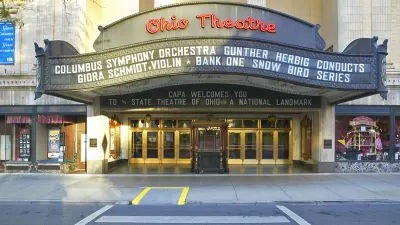The New York Times has given the city of Columbus an unequivocal stamp of approval, and without condescending to do it.

The latest sign of the development renaissance: a plan by Arshot Investment Corporation to build Millennial Tower, "a 25-story, $90 million, 400,000-square foot mixed-use development that includes 180,000 square feet of office space, 40,000 square feet of retail space and 100 apartments," according to Schneider. "Within a few blocks of the coming tower are five other buildings that are under construction or just opened, totaling $241 million in private investment to construct 275,000 square feet of office space, about 800 residential units and 80,000 square feet of retail space.
Schneider credits the downtown revitalization to a city income tax increase in 2009, among the other planning and design decisions that Columbus has implemented since—and there are a lot of projects and positives to describe. The feature-length article sends a resounding signal that Columbus, Ohio is a model of urban revitalization.
Susannah Elliott, a writer for The Columbus Dispatch, noticed the sober and thorough celebration of Columbus' achievements from the mainstream media. Usually, writes Elliott, "national publications…write gushing, but incredulous, stories about Columbus. You know, the 15th-largest U.S. city that most Americans still seem to dismiss as flyover country." In addition to noting what was different about Schneider's example, Elliott also provides a list of examples of the more incredulous variety.
FULL STORY: Open Spaces Bring Light to Downtown Columbus

Planetizen Federal Action Tracker
A weekly monitor of how Trump’s orders and actions are impacting planners and planning in America.

Restaurant Patios Were a Pandemic Win — Why Were They so Hard to Keep?
Social distancing requirements and changes in travel patterns prompted cities to pilot new uses for street and sidewalk space. Then it got complicated.

Map: Where Senate Republicans Want to Sell Your Public Lands
For public land advocates, the Senate Republicans’ proposal to sell millions of acres of public land in the West is “the biggest fight of their careers.”

Maui's Vacation Rental Debate Turns Ugly
Verbal attacks, misinformation campaigns and fistfights plague a high-stakes debate to convert thousands of vacation rentals into long-term housing.

San Francisco Suspends Traffic Calming Amidst Record Deaths
Citing “a challenging fiscal landscape,” the city will cease the program on the heels of 42 traffic deaths, including 24 pedestrians.

California Homeless Arrests, Citations Spike After Ruling
An investigation reveals that anti-homeless actions increased up to 500% after Grants Pass v. Johnson — even in cities claiming no policy change.
Urban Design for Planners 1: Software Tools
This six-course series explores essential urban design concepts using open source software and equips planners with the tools they need to participate fully in the urban design process.
Planning for Universal Design
Learn the tools for implementing Universal Design in planning regulations.
Heyer Gruel & Associates PA
JM Goldson LLC
Custer County Colorado
City of Camden Redevelopment Agency
City of Astoria
Transportation Research & Education Center (TREC) at Portland State University
Camden Redevelopment Agency
City of Claremont
Municipality of Princeton (NJ)




























